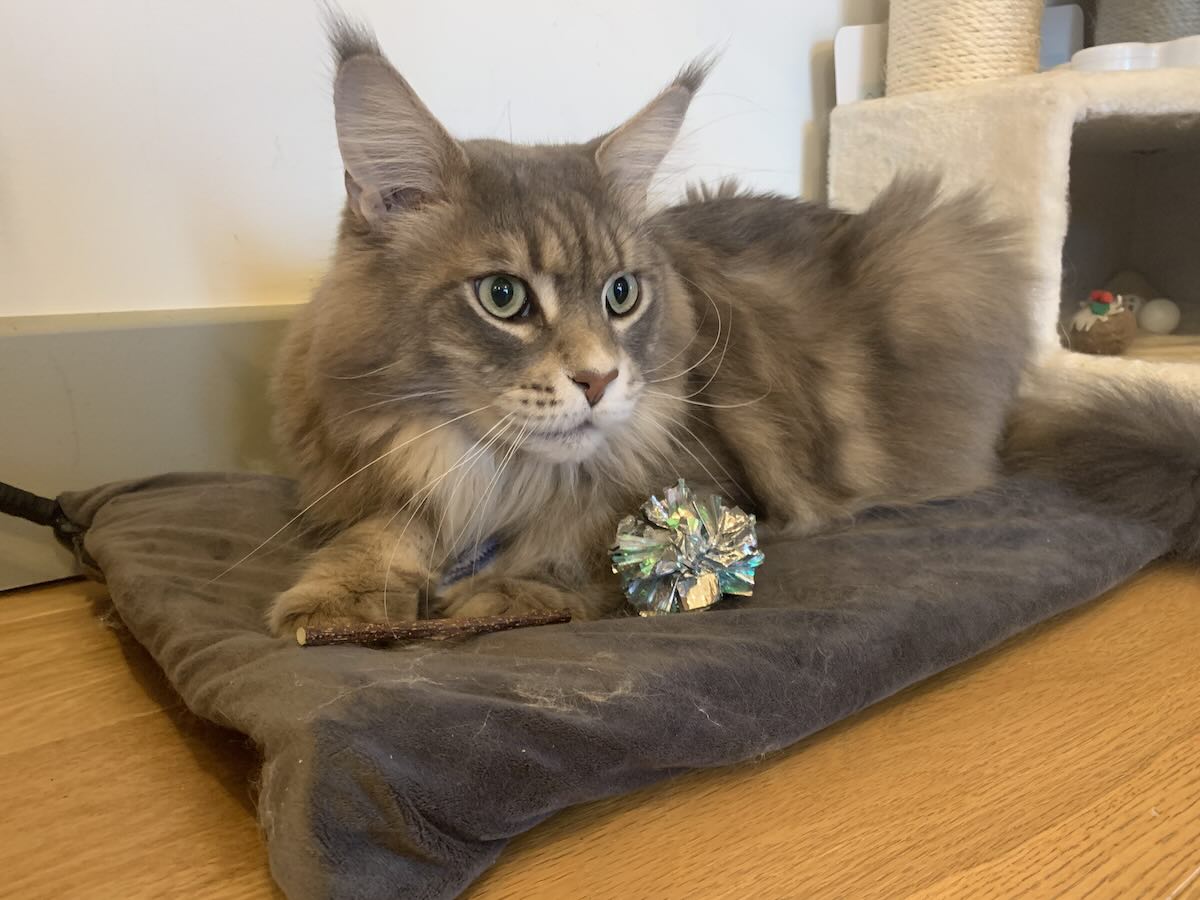Maine Coon Lynx Tips

Maine Coon lynx tips are the long, wispy tufts of fur that extend from the tips of their ears, giving them a wild, majestic appearance reminiscent of a lynx.
They are one of the breed’s most striking features, adding to their wild and regal look. But do all Maine Coons have them, and when do they develop?
What Are They?
Maine Coon lynx tips are the long, pointed tufts of fur that extend from the tips of their ears, resembling those of a wild lynx. These tufts can vary in length and thickness, giving the cat a more majestic and wild appearance.
Not all Maine Coons develop lynx tips, as it depends on genetics. And whilst some have long, dramatic tufts, others may have little to none.
Regardless, their large, well-furred ears still contribute to their stunning appearance.
What Is Their Purpose?
The Maine Coon’s lynx tips have various purposes, including:
✔ Protection – Helps keep dirt, debris, and moisture out of the ears, especially in outdoor environments.
✔ Temperature Regulation – In cold climates, they provide extra insulation by trapping warmth around the ears.
✔ Enhanced Hearing – While not scientifically proven, some believe lynx tips help funnel sound into the ears, improving a cat’s ability to detect noises.
✔ Camouflage & Evolutionary Traits – Resembling their wild ancestors, lynx tips may have played a role in helping Maine Coons blend into their natural surroundings.
Timescales
- Typically starts developing within the first few months of a kitten’s life, but may take up to a year or more to become prominent.
- Fully developed between 3-5 years old, once the cat reaches adulthood.
- Can vary in length, thickness, and visibility—some Maine Coons have dramatic, long tufts, while others have little to none due to genetics.
- Often accompanied by ear furnishings, which are the long tufts of fur inside the ears, helping to keep out dirt and debris.
How Common Are They?
Not all Maine Coons develop lynx tips. The presence and length of these tufts depend on genetics. Some cats may have:
- Long, prominent lynx tips that stand out and grow upwards.
- Short or minimal lynx tips, making them less noticeable.
- No lynx tips at all, though they may still have dense ear furnishings inside the ear.
How To Care For Them
🖤 Gentle Brushing – Use a soft brush or comb to prevent matting without pulling on the delicate tufts.
🖤 Avoid Trimming – Lynx tips naturally shed and regrow, so trimming isn’t necessary.
🖤 Check for Debris – Since long ear fur can trap dirt, inspect their ears regularly to keep them clean.
Other Names People Use
Maine Coon ear fur comes in different forms and is known by several names:
- Lynx Tips – The long, pointed tufts of fur extending from the tips of the ears.
- Ear Tufts – Sometimes used interchangeably with lynx tips but can also refer more broadly to fur around the ear.
- Ear Furnishings – The thick fur inside the ears that helps protect against dirt and cold.
For clarity, “lynx tips” is the best term when referring specifically to the fur on the tips of a Maine Coon’s ears.
Genetic Predisposition
The development of lynx tips in Maine Coons is primarily influenced by polygenic inheritance, meaning multiple genes contribute to the trait rather than a single dominant or recessive gene.
While the exact genetic basis isn’t fully mapped, here’s what we know:
Genetic Factors Behind Lynx Tips:
- Polygenic Influence – Lynx tips result from the combined effect of multiple genes, which regulate fur length, density, and ear structure.
- Long-Haired Gene (L Gene) – Maine Coons carry the L/L or L/l genotype, which determines their long, thick fur, including ear tufts and lynx tips.
- Furnishing Genes (FGF5 Mutations) – Genetic mutations related to fibroblast growth factor 5 (FGF5)contribute to long fur, which may extend to the ear tips.
- Selective Breeding – Breeders often select Maine Coons with prominent lynx tips to pass on the trait, making it more common in well-bred lines.
Why Don’t All Maine Coons Have Lynx Tips?
- Some Maine Coons inherit genes that result in shorter ear fur or less pronounced tips.
- The expression of lynx tips may be reduced due to environmental factors like climate or grooming habits.
- Certain bloodlines may carry weaker genetic expression for lynx tips, even if both parents have them.
While lynx tips add to the wild look of Maine Coons, they are purely aesthetic and don’t impact health or function.
Are Maine Coons Part Lynx?
Maine Coons are not part lynx – they are 100% domestic cats.
However, their large size, tufted ears (lynx tips), and rugged fur often make people wonder if they have wild ancestry, particularly from lynxes or bobcats.
Why Do People Think Maine Coons Are Part Lynx?
- Lynx Tips & Ear Furnishings: Many Maine Coons have long tufts of fur on their ear tips (similar to lynxes), as well as thick fur inside the ears to help with insulation.
- Large Size: Males can weigh 18-22 lbs (8-10 kg), making them one of the largest domestic cat breeds, sometimes as big as small wildcats.
- Fluffy Tails: Their bushy tails resemble those of wildcats like the Eurasian lynx.
- Myths & Legends: Folklore suggests Maine Coons descended from bobcats or Norwegian Forest Cats, but no genetic evidence supports this.
What Does Science Say?
Maine Coons do not have any wild DNA from lynxes or bobcats. They are purely domestic and descended from long-haired cats brought to North America by European sailors, where they adapted to the harsh Maine climate.
While they may look wild, Maine Coons have the same affectionate, social temperament as other domestic cats.





